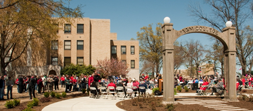This page will help you begin to prepare for minor and major emergencies on campus by providing basic safety info that you need to know on your first day. This is by no means the only steps you should take to protect and prepare yourself, but if you ever need emergency services on campus, the instructions below could save a life.
Calling Emergency Services from Campus
Call UPD first: 870-972-2093 or 2093 from a campus landline. Because our officers are more familiar with campus, the best way to get emergency services to your location is to call UPD directly. They can request resources from other EMS agencies, and help get them to you quickly. Save UPD's number to your cell phone, or post it in a readily accessible location.
However, 911 is an option everyone is familiar with. All 911 calls from campus are routed to the Craighead County E911 Center in Downtown Jonesboro. Here are a few things to keep in mind when dialing 911:
- From a landline - If calling from a campus desk phone, you still need to dial 9 to get an outside line. You will see instructions to dial (9)911 on university safety publications. One of the advantages of calling from a landline is that UPD dispatch is automatically notified of the call.
- From a cell phone - When calling from a cell phone, UPD does not receive automatic notification, but the county 911 center will notify, and if time permits, transfer your call to our UPD dispatch. Always tell the dispatcher you are calling from A-State's campus.
- Help responders find you - The more information you can provide to a dispatcher, the quicker emergency response personnel can find you. While there are ways for EMS units to coordinate locations, many of their mapping systems rely on physical addresses.
- For example, a paramedic might not know where the Math Building is, but can find you more quickly if you provide the address: 2405 Quapaw Trail. (See the bottom section to find your address)
- In addition, help can reach you faster if someone can meet EMS personnel at the main entrance, or at the entrance you direct them to when you call.
- Orient yourself with cardinal directions from inside your office or building - a 911 dispatcher might ask what side of the building they should send help to. You might not have windows, or are otherwise unfamiliar with compass directions, so it may take a conscious effort to learn which way north is.
- For example, a paramedic might not know where the Math Building is, but can find you more quickly if you provide the address: 2405 Quapaw Trail. (See the bottom section to find your address)
Learn Your Building Address Today
How often do you use the physical address of the building where you work? For most of us on campus, the answer is not very often. In fact, it is likely that the only time you will need your building's address is in an emergency. Below are a few ways to find your building's address. Do not rely on the following resources in an emergency - program them into your phone or post them near landlines or other easily accessible areas:
- Building Identification Signs
These are the large red signs in front of major buildings. The sign includes the building name, address number and street.
- Village Apartments have a gray sign out front, and the Village Houses have only the address number posted on the house itself.
- Red Wolf Dens, Honors LLC, ROTC LLC, STEM LLC, North Park Quads and Collegiate Park buildings have the red signs, but each set of buildings shares an address, and buildings are identified with single digit on the building itself.
- Village Apartments have a gray sign out front, and the Village Houses have only the address number posted on the house itself.
- Campus Maps
Facilities Management also maintains an Emergency Route Map. This map is designed to print to scale on 11x17" paper, and like most printed maps, contains an alpha-numeric grid and corresponding key on the second page with an alphabetical list of buildings, their addresses and grid coordinates. - Physical Address List
Facilities Management maintains an updated list of Physical Addresses for all campus buildings on its website. - Google Maps
Try searching or clicking your building on a Google Map view of campus. Your address will display under the building name on the left side of the page. Remember, the info on Google is often crowd-sourced, so mistakes happen. Contact Facilities Management at 870-972-2066 to report issues.
Make Sure You Can Receive Emergency Alerts
A-State Alerts are the primary way for campus emergency officials to communicate emergencies. These text messages to your mobile device include class cancellations due to emergency conditions, tornado warnings, all-clear statements, timely warnings, and other forms of hazard communication. These alerts are specific to the physical A-State campus. To sign up:
-
1. Log on to Pack.AState.edu2. Click on “Campus Tools”3. Select "Emergency Text Alerts"4. Enter up to 3 phone numbers5. Hit confirm
After you have signed up, you will want to verify that you are able to receive emergency alert texts. UPD tests the emergency alert system for text and email on the first Friday of each month. All university-assigned email accounts receive emergency alerts automatically. You can use this monthly email as a reminder to check the phone(s) you have signed up to receive emergency texts. If you do not receive a corresponding text, contact IT Services at 870-972-3933.
Emergency Action Plan
The Emergency Action Plan exists to provide campus members with the immediate procedures and information needed to respond to various crisis, emergency, and disaster situations. The Office of Emergency Management furnishes EAPs to increase uniformity, consistency, and overall confidence in the event of an emergency scenario. For additional information, you may contact the Office of Emergency Management at 870-972-2862.





